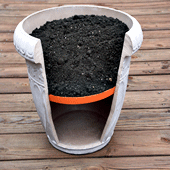There is a lot of sound advice available for planting pots window boxes and hanging baskets but some of it is only learned by trial and error. Preparing the pot is important. Preparing it to suit its location and your life style is even more important. Of course you want a planter that had adequate drainage but if it is a pot that is in the hot sun all day or you don’t water regularly the drainage can be adjusted to compensate. One of the ways to retain moisture is to put disposable diapers in the bottom of the pot. These hold water, which provides moisture for the plant roots as the soil dries.
Hanging baskets with a tray underneath provide a bit of extra water while not allowing roots lay in standing water. Many of the better hanging baskets act as self-watering planters. A shallow tray under a pot or planter can provide a safety factor should watering be neglected for a short period of time. Shallow is the operative criteria. If a planter is allowed to dry completely often water will run down the insides if the container and not be properly absorbed into the soil. A reservoir at the bottom will allow the soil to absorb the water slowly. While plants must have good drainage to support healthy root structure, drainage should not be so fast that the plant dries out too quickly.
baskets act as self-watering planters. A shallow tray under a pot or planter can provide a safety factor should watering be neglected for a short period of time. Shallow is the operative criteria. If a planter is allowed to dry completely often water will run down the insides if the container and not be properly absorbed into the soil. A reservoir at the bottom will allow the soil to absorb the water slowly. While plants must have good drainage to support healthy root structure, drainage should not be so fast that the plant dries out too quickly.
The current thinking is that putting gravel, rocks or pot shards in the bottom of pots does not facilitate drainage but hampers it. The theory is that water has difficulty passing from a finer medium to a coarser one and will cause the water to back up resulting in soggy soil. This is the total opposite of what has long been accepted as conventional planting technique. It is to be noted though that most hanging baskets now have a plastic planting insert as standard equipment. A piece of screening or one of these inserts is what is now suggested to keep the soil in the pot and to keep draining holes from clogging rather than the more conventional materials.
Use adequate soil in your pots. While it is tempting to fill the bottom of a big pot with plastic peanuts or other material to make the pot lighter and save soil this is probably not a good idea. While many annuals have a shallow root system and never reach the bottom of the pot the extra soil provides a steady level of moisture that the plants appreciate. As the soil dries out on top the plant will tend to put down deeper roots and develop a healthier and more extensive root system.
The verdict is still out on the hydrostatic crystals. While some people have found them useful in hanging baskets and pots, a number of people I have talked to don’t find them very effective. The main complaint is that they don’t seem to release water back into the soil very effectively. If you do use them make sure they are at the bottom of the pot and wet them before you put them in.
Unless you buy a potting soil that is complete with fertilizer it will be necessary to keep pots and planters fertilized. Some potting soils are not particularly fertile. The slow release fertilizer is efficient for planters because it will remain active for about 3 months and saves time and effort. Plants should be fertilized when they begin active growth. Until a plant adjusts it isn’t going to use much in the way of nutrients. Only when they begin to grow will they need adequate fertilizer. Plants in containers are planted more densely than they would be planted in the ground and should be fertilized accordingly.
While you cannot use unsterilized compost in house plants it seems to work quite well in outdoor planters. Mix it with sand, perlite or some other coarse material to facilitate drainage and peat moss to hold moisture. Peat moss also seems to control any disease organisms in the soil and will prevent damping off in seedlings if sprinkled on the top of the soil. Be advised that compost straight from the compost heap will contain weed seeds unless you have managed to get the entire compost pile hot enough to kill them. If you don’t want to deal with this problem use the compost at the bottom of the pot and use commercial potting soil on top.
Now the caveat: these are my personal observations for the most part. There is no absolute right way of doing anything in the gardening world. What works for one person in one locale will frequently be a dismal failure for another person in a different locale. We learn by trial and error.